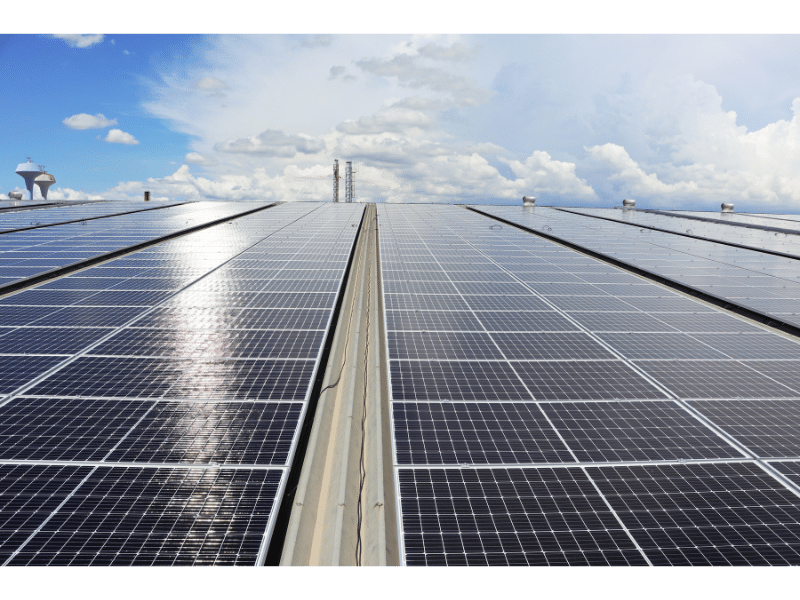If you are wondering how your business can maximize the value of your new solar system, an energy audit is the answer. Solar companies strive to size new PV systems for your current energy consumption but typically lack the expertise to identify energy efficiency opportunities. By decreasing your building’s energy use before installing solar, beginning with an energy audit, you can ensure you’re maximizing the value from your investment in solar.
Benefits of energy efficiency before solar
During an energy audit, a trained professional or engineer visits your building, identifies potential energy saving improvements, and recommends energy and cost-saving opportunities. It is the first step to decreasing your building’s energy use. By using less energy, you can potentially:
- decrease the cost of your solar project,
- offset a higher portion of your electricity usage,
- lower future energy costs,
- lower your carbon footprint further, and
- receive cost-effective peace of mind.
Many energy efficiency projects provide other benefits too. They can help fund and finance equipment replacements, improve comfort and control options, and lower maintenance costs. Utilities also offer potential incentives for these projects which make them more affordable.
Low costs, immediate benefit
An energy audit can usually identify energy saving opportunities with significant benefit that are inexpensive to implement and have immediate benefit.
When we conduct audits, we can tailor our recommendations to your economic criteria, and limit energy efficiency measures (energy saving opportunities) to those with a payback of 2 to 5 years. It is not uncommon to find measures like scheduling equipment or simple controls changes that have immediate payback.
Older buildings that predate current building codes often have potential measures with a 5 year or less payback. Lighting retrofits and electric water heater retrofits are examples that often fall under this threshold in areas with high-rate tariffs and warmer climates. If you plan to stay in the building long term and want to maximize your building’s energy efficiency potential, we can typically recommend measures with longer paybacks as well. For the sake of comparison, you can expect solar PV systems for commercial buildings to have a payback in the 10-year ballpark (this depends on several factors and should be provided based on your existing conditions by your solar integrator).
By implementing energy saving projects first, you can reduce your overall energy usage, and lower your carbon footprint. This may give you the option of reducing your solar array size, offset a higher percentage of your electricity use or the potential to meet future electric loads (like electric car charging or heat pump water heating) with your PV System.
Reduce demand charges
With most utility Time-of-Use rates, the cost of energy can vary significantly depending on the time of day. Peak hour electricity prices can be 2- or 3-times off-peak power costs, with peak hours in California from afternoon to early evening hours.
Depending on your rate tariff, you may also be subject to significant demand charges. Those demand charges can make up nearly half your bill and are based on the maximum power you use during any 15-minute interval in the billing period. Demand charges can be very costly to many businesses. A good energy audit will explore ways to shift your energy usage to hours when it is cheaper and lower demand charges, while minimizing the impact on occupants.
For example, if you have older, manually controlled AC thermostats you can replicate some if the demand response capabilities of the newest energy management systems by installing WiFi-enabled thermostats. Using these thermostats can significantly reduce your average energy costs. This approach allows you to buy more of your building’s electricity from the utility when it is cheapest, and send more of your solar energy back to the grid when it is most valuable, increasing the value of the power produced by your solar system.
Second professional opinion
If you have solar installation quotes in hand, an energy audit can provide a third-party review of the cost models used by your solar installer. A good auditor (learn what to look for when hiring an energy auditor) can also provide input on any proposals you may have for installing energy storage systems, which can be cost-effective when paired with solar, but require careful attention to your building’s hourly energy use profile.
Getting started with an energy audit
The California Solar Initiative (CSI) once required energy audits prior to providing solar incentives because of these reasons. Although incentives are no longer available due to the lower cost of solar, the simple logic of it still rings true: it is cheaper to reduce your energy usage before you buy solar. If you’d like to discuss your options to maximize the value of solar or implementing energy saving projects, contact us anytime.


